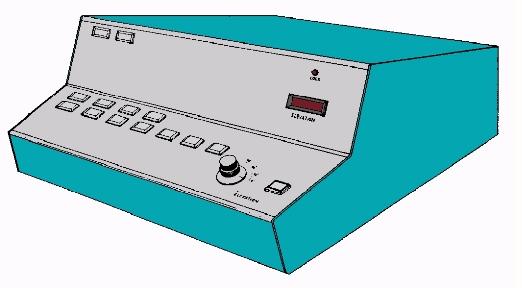GENERAL DESCRIPTION
 |
|
Radar Simulator Console (1)
|
The Weather Watch Radar Simulator was built by the Radar Engineering Section in 1979 for Training School. Engineer Vladimir Kondratiev was responsible for the design whilst Chris Heal and Harvey Edwards had the task of building it.The aim was to provide Training School with the facility to train Observers in the use of Weather Radar on cyclone and other storm data, whenever desired in the Central Training School in Melbourne.
It used a National NV-9200 U-Matic VCR for storage and replay of radar data in the Radarplex Video format.. This VCR in particular was chosen because of its cast metal base which made it more rugged for a life of be shipped from radar to radar recording data for the Simulator to replay.
A VCR along with a cable set was sent to Radarplex stations prior to the cyclone season, so the on-site technician could connect it at the remote operating console to record any serious weather events. Hence this modified VCR would record the Radarplex Video data transmitted from the radar head site. That video tape then could be replayed by the Simulator, which was very similar to a Radarplex Video Receiver frame.
For a display an EEC standalone PPI was employed. This PPI was the only one purchased from EEC as a separate item. A synchro modulator converted the received resolver signals into synchro drive for the PPI.
Most of the boards in the Simulator Console were from the Radarplex Video Receiver system. Two specialist functions were for the elevation and attenuation controls.
The elevation control & readout
This was an interesting function - particularly if you consider the idea of
raising the elevation on radar data that was recorded at a single elevation
many months or years before! Obviously some trickery had to be employed here.
It was simply a variable video attenuator control marked in degrees of elevation.
The 'Law of Attenuation VS Elevation angle' was established by trial and error
and occasionally the Training instructors would complain that the storm heights
were not very realistic.
For the elevation digital readout, a LED DVM (Digital Voltmeter) kit utilising the Intersil ICL7107 chip simply converted the attenuating voltage to a numerical readout which was labeled in degrees elevation.
The Attentuator control
The console had the same attenuator buttons as a WF44 radar for making rainfall
rate measurements. Thus the trainee could perform the standard observation tasks
as they would on a real radar.
National NV-9200
The National NV-9200 U-Matic machine was a top-loader. It used the U-Matic format
introduced by Sony in 1971 with a three-quarter inch tape cassette. It was commonly
used in TV studios in the late seventies and eighties had much better signal-to-noise
ratio than Super VHS. The U-Matic tape transport was also much faster in changing
modes. The relatively low tape costs and low recording density, made the tapes
robust against aging. This particular National VCR was chosen because of its
case metal base which would made it quite rugged for the role it was to play
being shipped around Australia recording weather events for use on the Simulator.
References
(1) Equipment handbook EH530